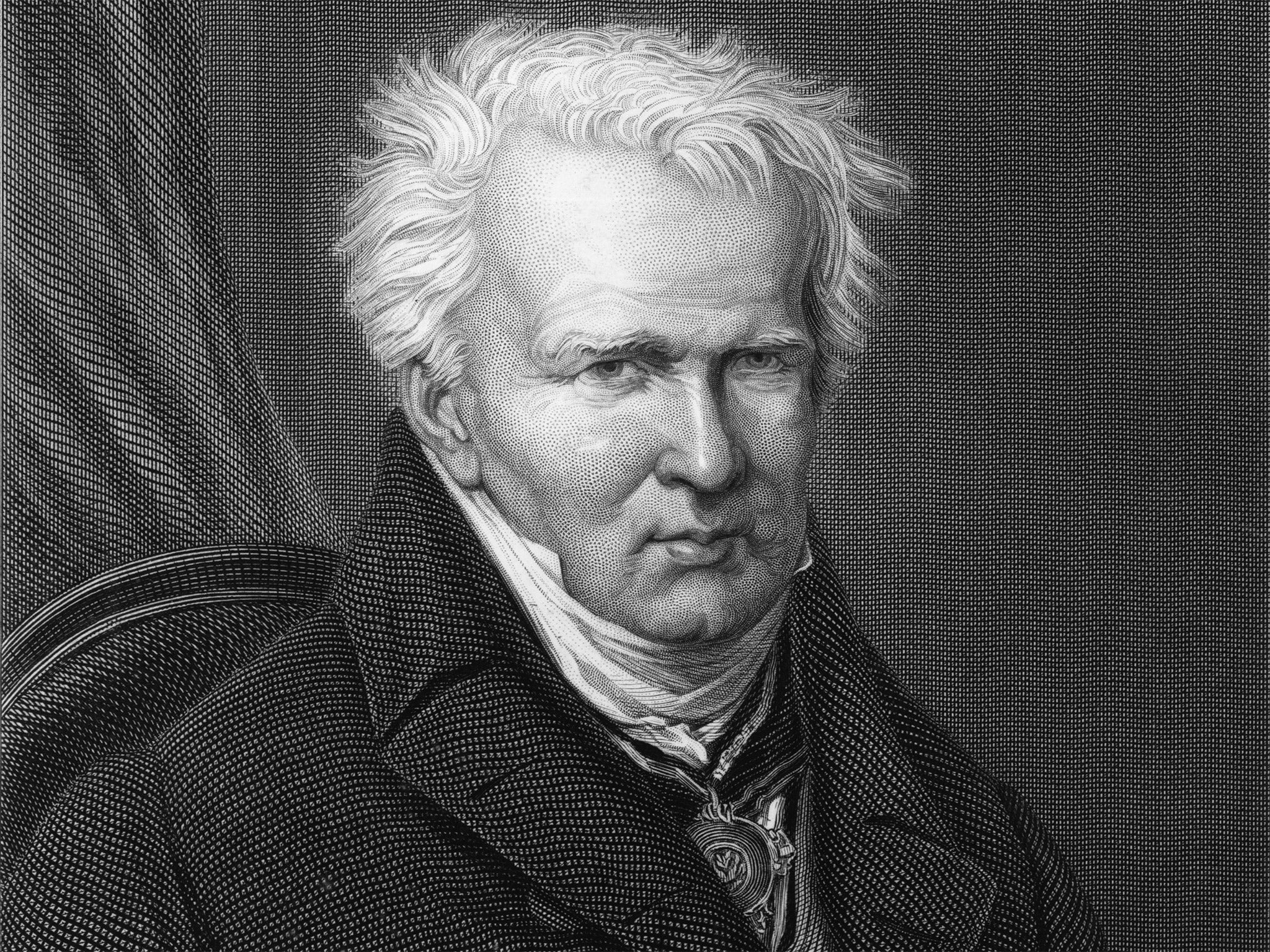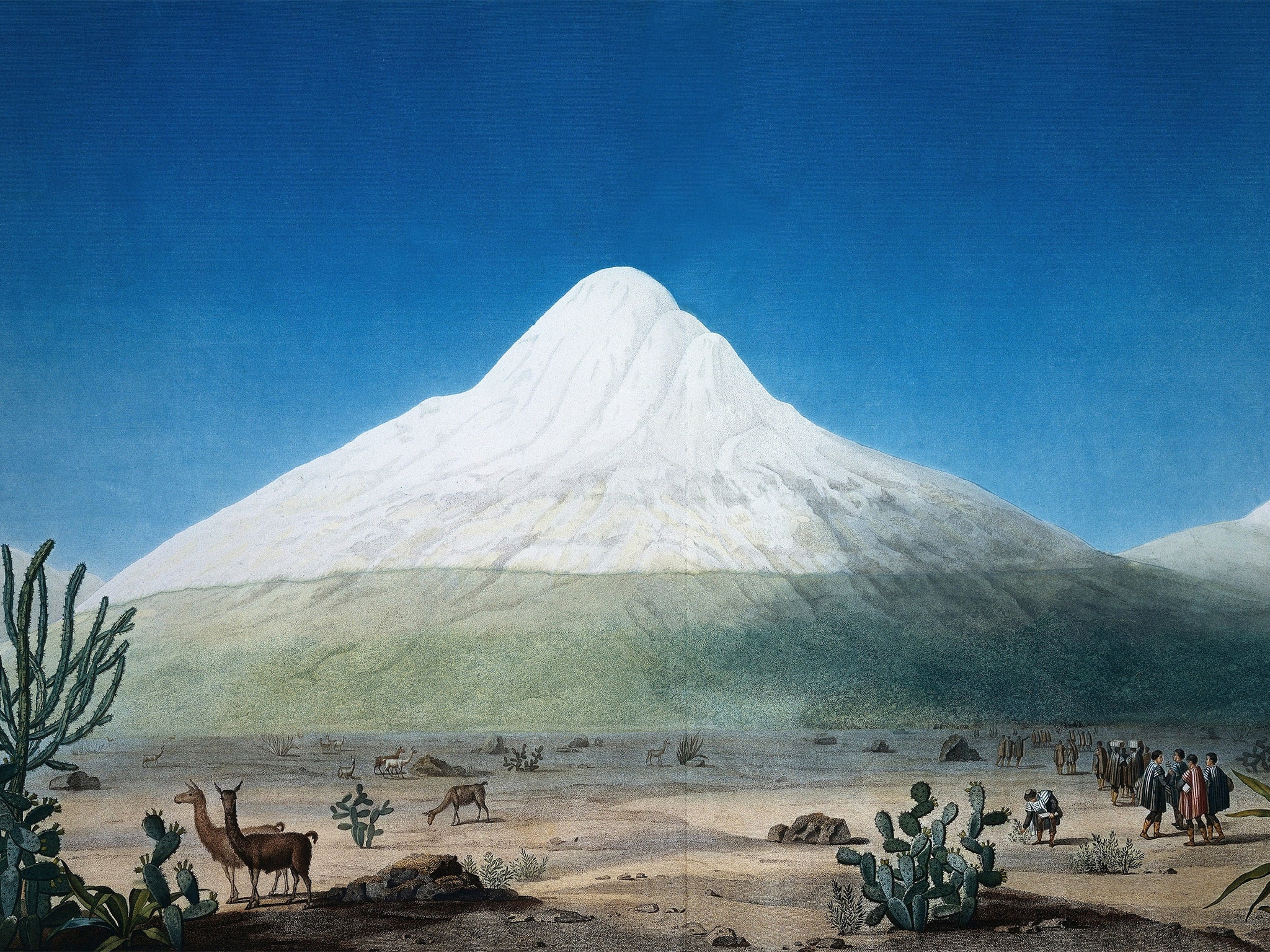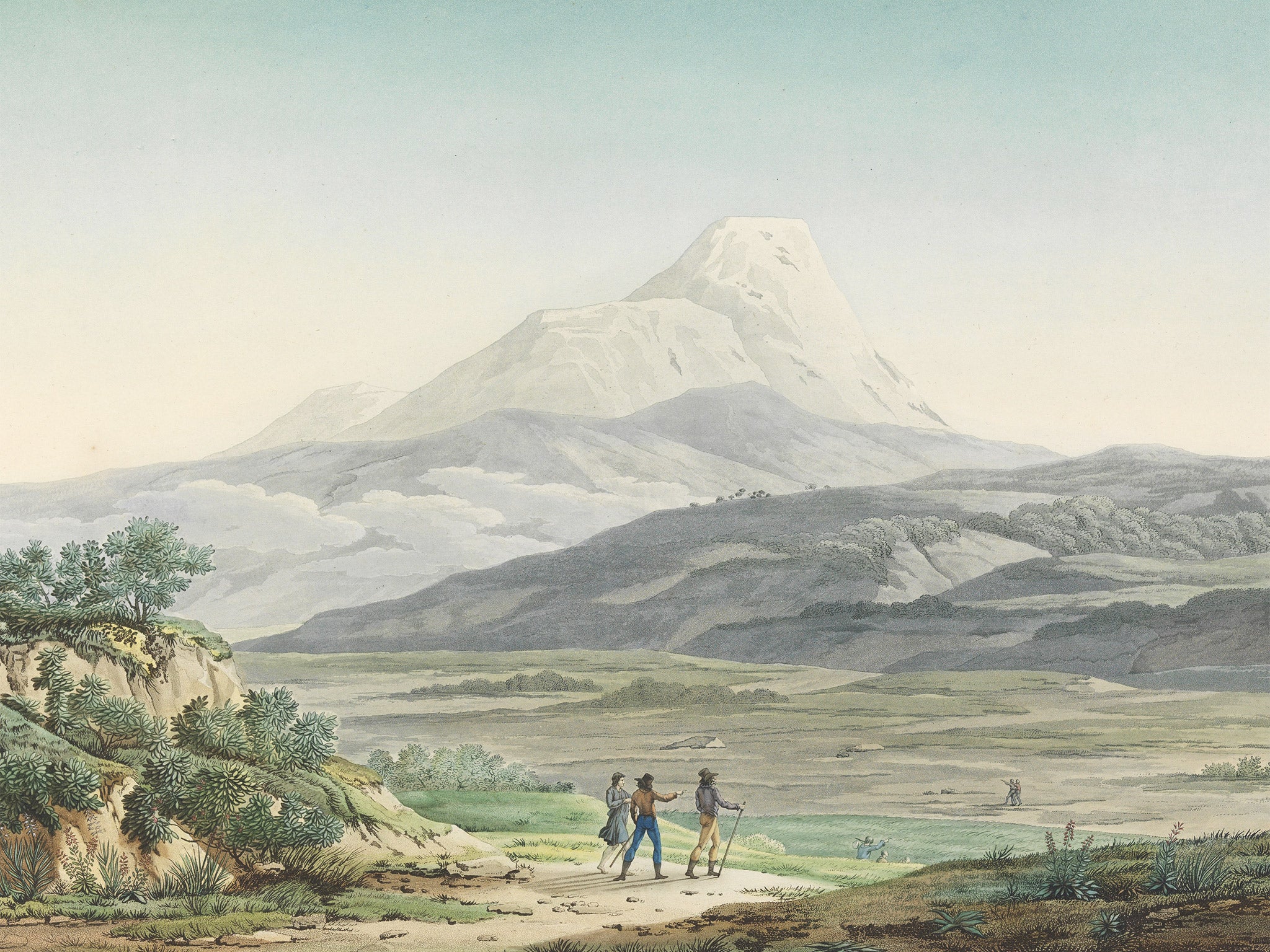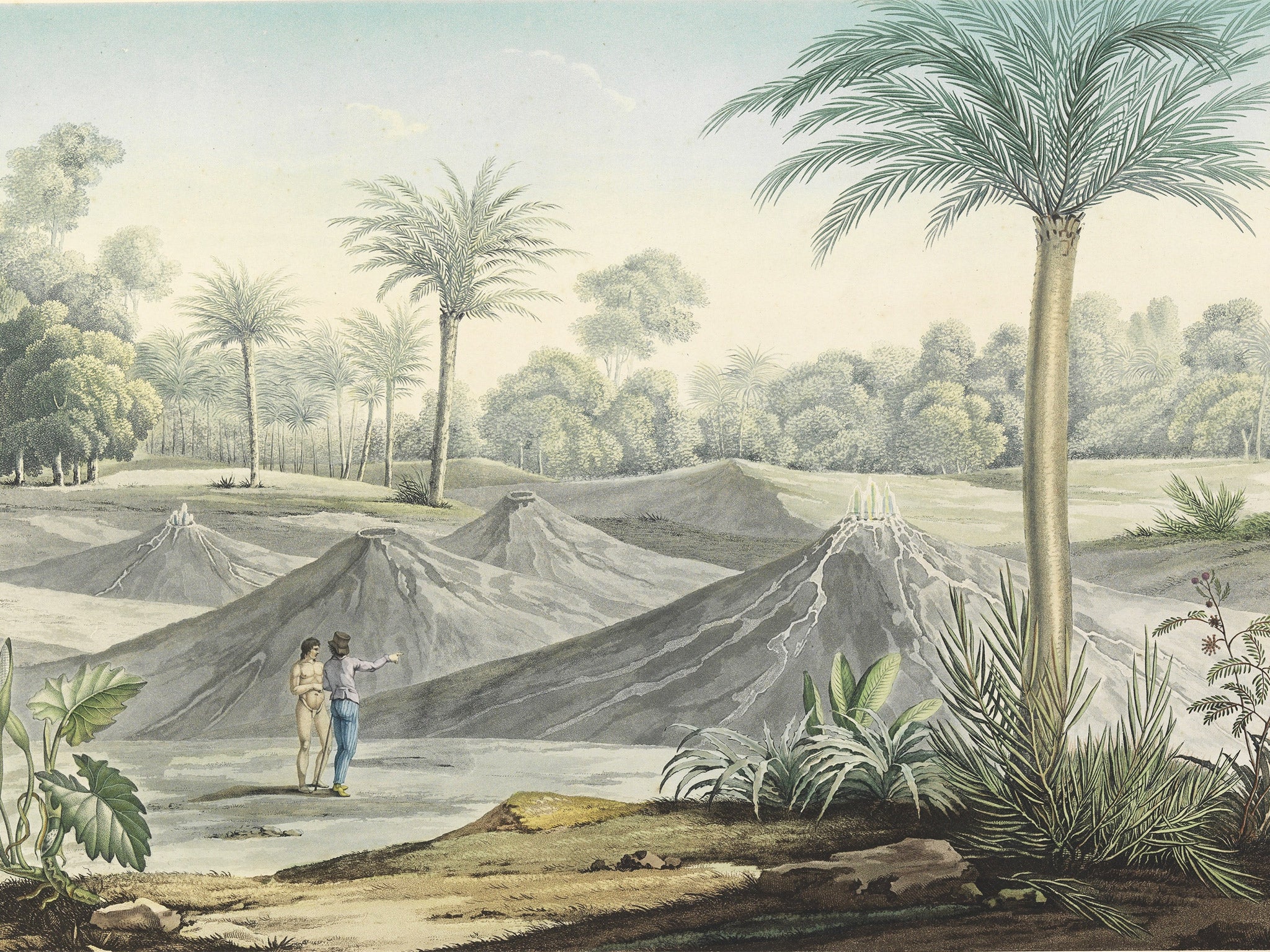Alexander von Humboldt: The eccentric explorer was 'the most famous man in the world after Napoleon’
Andrea Wulf has written a biography about the Prussian-born gadget-lover and climate-change pioneer

Your support helps us to tell the story
From reproductive rights to climate change to Big Tech, The Independent is on the ground when the story is developing. Whether it's investigating the financials of Elon Musk's pro-Trump PAC or producing our latest documentary, 'The A Word', which shines a light on the American women fighting for reproductive rights, we know how important it is to parse out the facts from the messaging.
At such a critical moment in US history, we need reporters on the ground. Your donation allows us to keep sending journalists to speak to both sides of the story.
The Independent is trusted by Americans across the entire political spectrum. And unlike many other quality news outlets, we choose not to lock Americans out of our reporting and analysis with paywalls. We believe quality journalism should be available to everyone, paid for by those who can afford it.
Your support makes all the difference.They were crawling on hands and knees along a high, narrow ridge that was in places only two inches wide. The path, if you could call it that, was layered with sand and loose stones that shifted whenever touched. Down to the left was a steep cliff encrusted with ice that glinted when the sun broke through the thick clouds. The view to the right, with a 1,000ft drop, wasn't much better. Here the dark, almost perpendicular walls were covered with rocks that protruded like knife blades. Alexander von Humboldt and his three companions moved in single file, slowly inching forward.
Without proper equipment or appropriate clothes, this was a dangerous climb. The icy wind had numbed their hands and feet, melted snow had soaked their thin shoes and ice crystals clung to their hair and beards. At 17,000ft (5,180m) above sea level, they struggled to breathe in the thin air. As they proceeded, the jagged rocks shredded the soles of their shoes, and their feet began to bleed.
It was 23 June 1802, and they were climbing Chimborazo, a beautiful, dome-shaped inactive volcano in the Andes that rose to almost 21,000 feet, some 100 miles to the south of Quito in today's Ecuador. Chimborazo was then believed to be the highest mountain in the world. No wonder their terrified porters had abandoned them at the snow lin e. The volcano's peak was shrouded in thick fog, but Humboldt had nonetheless pressed on.
For the previous three years, Humboldt had been travelling through Latin America, penetrating deep into lands where few Europeans had ever gone before. Obsessed with scientific observation, the 32-year-old had brought a vast array of the best instruments from Europe. For the ascent of Chimborazo, he had left most of the baggage behind, but had packed a barometer, a thermometer, a sextant, an artificial horizon and a so-called "cyanometer" with which he could measure the "blueness" of the sky. As they climbed, Humboldt fumbled out his instruments with numb fingers, setting them upon precariously narrow ledges to measure altitude, gravity and humidity. He meticulously listed any species encountered – here a butterfly, there a tiny flower. Everything was recorded in his notebook.

At 18,000ft, they saw a last scrap of lichen clinging to a boulder. After that, all signs of organic life disappeared. Even the condors that had accompanied their previous climbs were absent. As the fog whitewashed the air into an eerie empty space, Humboldt felt completely removed from the inhabited world. "It was," he said, "as if we were trapped inside an air balloon." Then, suddenly, the fog lifted, revealing Chimborazo's snow-capped summit against the blue sky. A "magnificent sight", was Humboldt's first thought, but then he saw the huge crevasse in front of them – 65ft wide. But there was no other way to the top. When Humboldt measured their altitude at 19,413ft, he discovered that they were barely 1,000 feet below the peak.
No one had ever come this high before, and no one had ever breathed such thin air. As he stood at the top of the world, looking down upon the mountain ranges folded beneath him, Humboldt began to see the world differently. He saw the earth as one great living organism where everything was connected, conceiving a bold new vision of nature that still influences the way that we understand the natural world. Described by his contemporaries as the most famous man in the world after Napoleon, Humboldt was one of the most captivating and inspiring men of his time.
Born in 1769 into a Prussian aristocratic family, he discarded a life of privilege to discover for himself how the world worked. As a young man, he set out on a five-year exploration of Latin America, risking his life many times and returning with a new sense of the world. He lived in cities such as Paris and Berlin, but was equally at home on the most remote branches of the Orinoco River or on the Kazakh Steppe. During much of his long life, he was the nexus of the scientific world, writing some 50,000 letters and receiving at least double that number. Knowledge, Humboldt believed, had to be shared, exchanged and made available to everybody.
He was also a man of contradictions. He was a fierce critic of colonialism and supported the revolutions in Latin America, yet was chamberlain to two Prussian kings. He admired the United States for its concepts of liberty and equality but never stopped criticising its failure to abolish slavery. He called himself "half an American", but at the same time compared America to "a Cartesian vortex, carrying away and levelling everything to dull monotony".
Goethe declared that spending a few days with Humboldt was like ‘having lived several years’
He was confident, yet constantly yearned for approval. His books were published in a dozen languages and were so popular that people bribed booksellers to be the first to receive copies, yet he died a poor man. He could be vain, but would also give his last money to a struggling young scientist. He packed his life with travels and incessant work. He always wanted to experience something new and, as he said, ideally, "three things at the same time".
Humboldt was no cerebral scholar. Not content among books, he threw himself into physical exertion, pushing his body to its limits. Fascinated by scientific instruments, measurements and observations, he was driven by a sense of wonder as well. Of course nature had to be measured and analysed, but he also wanted to excite a "love of nature". At a time when other scientists were searching for universal laws, he wrote that nature had to be experienced through feelings.
Humboldt was unlike anybody else because he was able to remember even the smallest details for years: the shape of a leaf, the colour of soil, a temperature reading, the layering of a rock. This extraordinary memory allowed him to compare the observations he had made all over the world several decades or thousands of miles apart. Where others had to ransack their memories, Humboldt – "whose eyes are natural telescopes & microscopes", as the American writer and poet Ralph Waldo Emerson said in admiration – had every morsel of knowledge and observation to hand at an instant.
As he stood on Chimborazo, exhausted by the climb, Humboldt absorbed the view. Here, vegetation zones were stacked one on top of the other. In the valleys, he had passed through palms and humid bamboo forests where colourful orchids clung to the trees. Further up he had seen conifers, oaks, alders and shrub-like berberis similar to those he knew from European forests. Then had come alpine plants much like those he had collected in the mountains in Switzerland and lichens that reminded him of specimens from the Arctic Circle. No one had looked at plants like this before. Humboldt saw them not through the narrow categories of classification but as types according to their location and climate. Here was a man who viewed nature as a global force with corresponding climate zones across continents: a radical concept that still colours our understanding.

Humboldt's books, diaries and letters reveal a visionary, far ahead of his time. He invented isotherms – the lines of temperature and pressure that we see on today's weather maps – and he also discovered the magnetic equator. He came up with the idea of vegetation and climate zones that snake across the globe. Most important, though, he found connections everywhere. Nothing, not even the tiniest organism, was looked at alone. "In this great chain of causes and effects," Humboldt said, "no single fact can be considered in isolation." With this insight, he invented the web of life.
When nature is perceived as a web, its vulnerability also becomes obvious. Everything hangs together. If one thread is pulled, the whole tapestry may unravel. After he saw the devastating effects of colonial plantations at Lake Valencia in Venezuela in 1800, Humboldt became the first scientist to talk about harmful human-induced climate change. Deforestation there had made the land barren, the lake's water levels were falling and, with the disappearance of brushwood, torrential rains had washed away the soils on the surrounding slopes.
Humboldt was the first to explain the forest's ability to enrich the atmosphere with moisture, and its cooling effect, as well as its importance for water retention and protection against soil erosion. He warned that humans were meddling with the climate and that this could have an unforeseeable impact on "future generations".
Another web still connects us to this extraordinary man. Humboldt influenced many of the greatest thinkers, artists and scientists of his day. Thomas Jefferson called him "one of the greatest ornaments of the age". Charles Darwin wrote that no one "stimulated [his] zeal so much" as Humboldt, saying he would not have boarded the Beagle nor conceived The Origin of Species without him. Wordsworth and Coleridge both incorporated Humboldt's concept of nature into their poems. And America's most revered nature writer, Henry David Thoreau, found in his books an answer to his dilemma on how to be a poet and a naturalist (Walden would have been a very different book without Humboldt). Simon Bolivar, the revolutionary who liberated South America from Spanish colonial rule, called Humboldt the "discoverer of the New World" and Johann Wolfgang von Goethe, Germany's greatest poet, declared that spending a few days with Humboldt was like "having lived several years".
On 14 September 1869, one hundred years after his birth, Alexander von Humboldt's centennial was celebrated across the world. There were parties in Europe, Africa and Australia as well as the Americas. In Melbourne, Mexico, Moscow and Alexandria, people came together to listen to speeches in honour of Humboldt. In the United States, from San Francisco to Philadelphia, from Chicago to Charleston, the nation saw street parades, sumptuous dinners and concerts. In Cleveland, some 8,000 people took to the streets and in Syracuse another 15,000 joined a march that was more than a mile long. President Ulysses Grant attended the celebrations in Pittsburgh together with 10,000 revellers who brought the city to a standstill.
In New York City, the cobbled streets were lined with flags. City Hall was veiled in banners, and entire houses vanished behind huge posters bearing Humboldt's face. The ships sailing by on the Hudson were garlanded in colourful bunting, and thousands of people followed 10 marching bands from the Bowery to Central Park to honour a man "whose fame no nation can claim" as The New York Times reported. By early afternoon, 25,000 onlookers had assembled in Central Park to listen to the speeches as a large bronze bust of Humboldt was unveiled. In the evening as darkness settled, a torchlight procession of 15,000 people set out.
Let us imagine him, one speaker said, "as standing on the Andes" with his mind soaring above all. Every speech across the world emphasised that Humboldt had seen an "inner correlation" between all aspects of nature. His fame, The Daily News in London reported, was "in some sort bound up with the universe itself".
Though today almost forgotten outside academia – at least in the English-speaking world – Humboldt's ideas still shape our thinking. And his name lingers everywhere from the Humboldt Current running along the coast of Chile and Peru to dozens of monuments, parks and mountains in Latin America, including Sierra Humboldt in Mexico and Pico Humboldt in Venezuela. There is a town in Argentina, a river in Brazil, a geyser in Ecuador and a bay in Colombia. There are Kap Humboldt and Humboldt Glacier in Greenland, as well as mountain ranges in northern China, South Africa, New Zealand and Antarctica. There are rivers and waterfalls in Tasmania and New Zealand as well as parks in Germany and Rue Alexandre de Humboldt in Paris.

In North America alone, four counties, 13 towns, mountains, bays, lakes and a river are named after him, as well as the Humboldt Redwoods State Park in California and Humboldt Parks in Chicago and Buffalo. The state of Nevada was almost called Humboldt when the Constitutional Convention debated its name in the 1860s. Almost 300 plants and more than 100 animals are named after him – including the Californian Humboldt lily (Lilium humboldtii), the South American Humboldt penguin (Spheniscus humboldti) and the fierce predatory 6ft Humboldt squid (Dosidicus gigas). Several minerals carry his name – from Humboldtit to Humboldtin – and on the moon there is an area called "Mare Humboldtianum". More places are named after Humboldt than anyone else.
Ecologists, environmentalists and nature writers rely on Humboldt's vision, although most do so unknowingly. Rachel Carson's Silent Spring is based on Humboldt's concept of interconnectedness, and scientist James Lovelock's famous Gaia theory of the earth as a living organism bears remarkable similarities. (Humboldt called his book describing this new concept Cosmos, having initially considered – but then discarded – "Gäa" as a title.)
We are shaped by ideas from the past, and Humboldt gave us the very concept of nature that we hold today. But ironically, his views became so self-evident that we have largely forgotten the man behind them. And that's what has impelled me to rescue him for a new generation – in a journey across the world, reading thousands of letters in archives but also following Humboldt's footsteps. I saw the ruin of the anatomy tower in Jena in Germany where he spent many weeks dissecting animals, and at 12,000ft on the Antisana in Ecuador, with four condors circling above and surrounded by a herd of wild horses, I found the dilapidated hut where he had spent a night in March 1802.
In Quito, I held Humboldt's original Spanish passport in my hands – the very papers that allowed him to travel through Latin America. In Berlin, I finally understood how his mind worked when I opened the boxes that contained his notes – marvellous collages of thousands of bits of paper, sketches and numbers. Closer to home, at the British Library, I spent many weeks reading Humboldt's published books, some so huge and heavy that I could scarcely lift them on to the table. In Cambridge I looked at Darwin's own copies of Humboldt's books – those he had kept on a shelf next to his hammock on the Beagle – filled with his pencil marks. It was like eavesdropping on Darwin talking to Humboldt.
I found myself lying at night in the Venezuelan rainforest listening to the bellows of howler monkeys, but also walking around Thoreau's Walden Pond in deep, freshly fallen snow.
The most exciting moment was when I finally climbed Chimborazo, the mountain so elemental to Humboldt's vision. As I walked up the barren slope, the air was so thin that every step felt like an eternity, and I thought of him climbing Chimborazo with an injured foot (and no walking boots as comfortable and sturdy as mine), loaded with instruments and constantly stopping to take measurements. My admiration for him grew with every step.
'The Invention of Nature: The Adventures of Alexander von Humboldt, the Lost Hero of Science' (£25, John Murray) is out now
Join our commenting forum
Join thought-provoking conversations, follow other Independent readers and see their replies
Comments